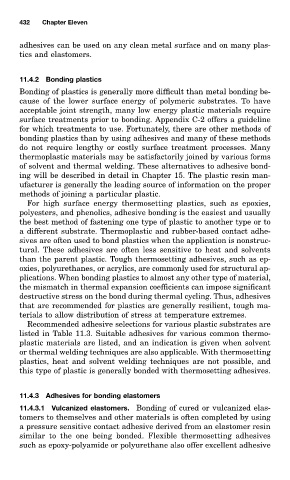Page 500 - Handbook of Adhesives and Sealants
P. 500
432 Chapter Eleven
adhesives can be used on any clean metal surface and on many plas-
tics and elastomers.
11.4.2 Bonding plastics
Bonding of plastics is generally more difficult than metal bonding be-
cause of the lower surface energy of polymeric substrates. To have
acceptable joint strength, many low energy plastic materials require
surface treatments prior to bonding. Appendix C-2 offers a guideline
for which treatments to use. Fortunately, there are other methods of
bonding plastics than by using adhesives and many of these methods
do not require lengthy or costly surface treatment processes. Many
thermoplastic materials may be satisfactorily joined by various forms
of solvent and thermal welding. These alternatives to adhesive bond-
ing will be described in detail in Chapter 15. The plastic resin man-
ufacturer is generally the leading source of information on the proper
methods of joining a particular plastic.
For high surface energy thermosetting plastics, such as epoxies,
polyesters, and phenolics, adhesive bonding is the easiest and usually
the best method of fastening one type of plastic to another type or to
a different substrate. Thermoplastic and rubber-based contact adhe-
sives are often used to bond plastics when the application is nonstruc-
tural. These adhesives are often less sensitive to heat and solvents
than the parent plastic. Tough thermosetting adhesives, such as ep-
oxies, polyurethanes, or acrylics, are commonly used for structural ap-
plications. When bonding plastics to almost any other type of material,
the mismatch in thermal expansion coefficients can impose significant
destructive stress on the bond during thermal cycling. Thus, adhesives
that are recommended for plastics are generally resilient, tough ma-
terials to allow distribution of stress at temperature extremes.
Recommended adhesive selections for various plastic substrates are
listed in Table 11.3. Suitable adhesives for various common thermo-
plastic materials are listed, and an indication is given when solvent
or thermal welding techniques are also applicable. With thermosetting
plastics, heat and solvent welding techniques are not possible, and
this type of plastic is generally bonded with thermosetting adhesives.
11.4.3 Adhesives for bonding elastomers
11.4.3.1 Vulcanized elastomers. Bonding of cured or vulcanized elas-
tomers to themselves and other materials is often completed by using
a pressure sensitive contact adhesive derived from an elastomer resin
similar to the one being bonded. Flexible thermosetting adhesives
such as epoxy-polyamide or polyurethane also offer excellent adhesive

